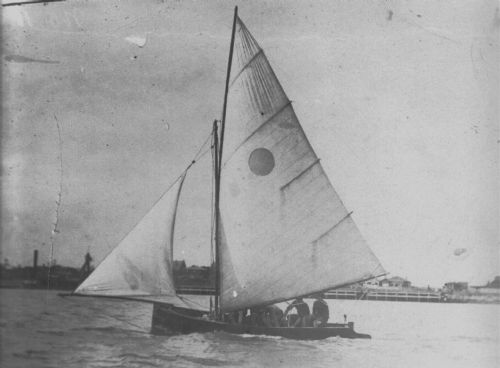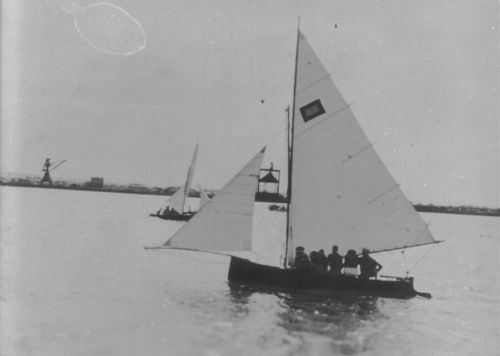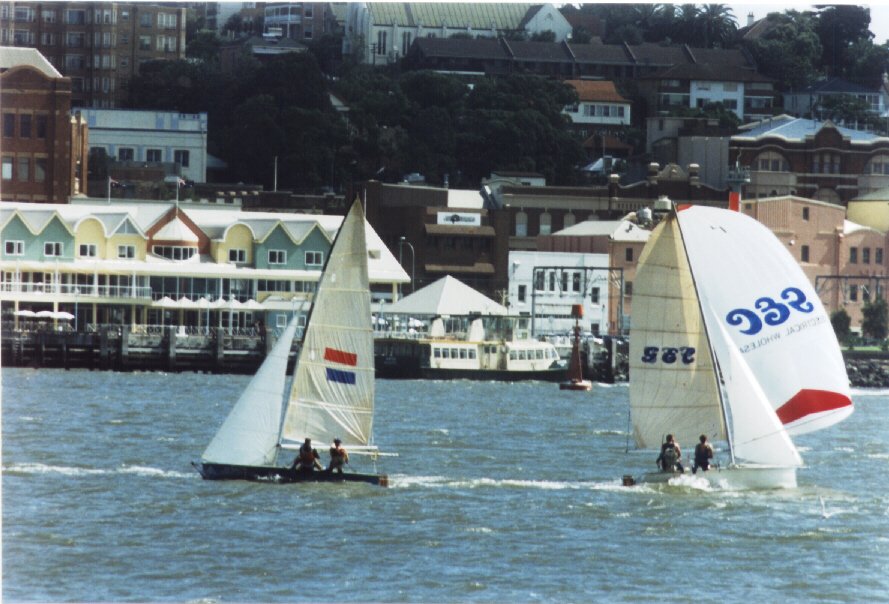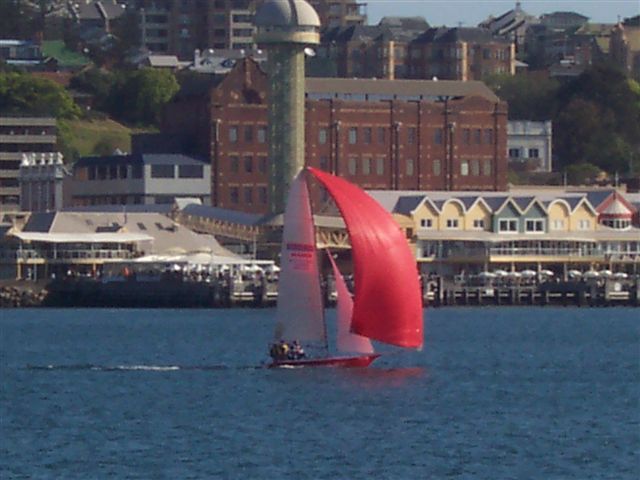Club History
Last updated 5th January 2005
Skiff sailing on Newcastle Harbour can be traced back to the early 1800s with the first organised Regatta being held in 1834. This regatta changed the port from a commercial waterway into a public festival and playground. The day was proclaimed as one of rest and friendly competition. Local crowds flocked to the foreshore to see the Butcher Boats in competition, not to provodore the arriving ships, but for the joy of it. The waterway was filled with sails and a carnival atmosphere prevailed. Over the years the event became known as the Newcastle Harbour Regatta and was usually held on New Years Day or Anniversary Day. During the mid to late 1800s the Regatta was a day-long series of events and the participants included crews from the merchant vessels and steamers in harbour at the time as well as the local watermans and fishermans skiffs under working sails.
The Mercantile Rowing Club was established on November 9th 1884 at the present site of the Port Hunter 16ft Skiff sailing Club at Stockton, just north of the old punt wharf. Mrs Clarence Hannel officially opened the new club whose members came from the ranks or men who plied the waters of Newcastle Harbour for a living. (The clubhouse was built over the water, which proved interesting, and wet, at the king tides and during floods). A couple of 14ft sailing dinghies were also used at the newly formed club.
Regular skiff sailing on the harbour started in 1895 with the establishment of the Port Hunter Sailing Skiff Club catering for skiffs ranging from 6ft to 22ft. A trophy donated for the 1895 Regatta by the Mayor of Newcastle, Alderman David Miller, was on display in the Newcastle City hall until quite recently. In 1889 the Stockton Sailing Club was officially launched, sailing 10ft, 14ft and 22 ft watermans skiffs. Sailors dress standards were impeccible, with top hats, jackets and ties being the standard of dress on the 22-foot skiffs. (This club incorporated all previous efforts at forming a club.)
By 1897 the Mercantile Rowing Club had foundered and the building and chattels was sold at auction for seventy-five pounds. The purchaser, the Reverend R. W. James used the building as the Seamans Mission after evacuating from St Pauls Church hall. The mission operated in the building until 1913 when it was moved to the corner of Hereford and Fullerton Streets, where today stands the Wescott Chapel.
The following extract is taken from the Newcastle Herald of 11 March 1900 reporting on the February Stockton Sailing Club regatta...
"Never since the formation of the club were the steamers and wharves so densely thronged. The wharf from Newcommen Street to Perkins Street was packed with sightseers. Also at last Saturday afternoon there were 9 for the 18 footers and 16 for the 10 footer classes. The snowy white sails in the distance reminded one of a patch of tents on the goldfields. Three steamers followed the race, including the GOSFORD, on board was a band which discoursed some excellent music during the afternoon."
In 1902, although the club had no boatshed or clubhouse, the name was changed to the Port Hunter Sailing Club. The biggest event was the annual Port Hunter Regatta, which was held "about New Years Day or on Anniversary Day" (I guess it depended on the hangovers).
The 5th annual general meeting at the Royal Exchange Hotel in 1903 was presided over by Mr S Arnott, the Commodore. The program showed the racing season commenced on 4th October 1902 and concluded on 9th February 2003. There were 16 events contested, the prize money totalling £48/10/10 of which £18/10/0 went to the fourteen footers and over £18 to the 10 footers. The report also indicated that the members boat OLGA had won the interstate championship, which was sailed against the Queensland Dinghy Club. At this meeting, membership fees were increased to two shillings and sixpence.
In the Minutes of a meeting held on the 25th September 1903 the 10 footers owners all indicated they would take their boats to Sydney to compete in the races to be held on 26th and 30th January. It was also decided to thank Messrs. M.A. and H. Callen for the free use of the steamer ROSE at Saturday races and the steamers STORM KING and LILY for harbour trips on New Years day.
For a number of years the 10ft and 18ft skiffs held pride of place among open boats on Newcastle Harbour, but by 1909 the Port Jackson skiff was becoming very popular in the area. Also about that time, after several locations in Stockton, the Port Hunter Sailing Club and the Port Hunter Rowing Club were given permission to occupy the former Seamans Mission premises on the site of the present Clubhouse. In that year the name of the club was changed to Port Hunter 16ft Sailing Skiff Club reflecting the introduction of the Port Jackson skiff as the official 16 foot skiff class. The Stockton Band playing marches and classical music aboard the Belgian Sail Training Ship, the flagship for the regatta, heralded the New Years Day regatta in 1910.
Although the date of the first regatta at Mungo Brush is not available, they were in full swing by 1911 with dedicated members loading boats, tents and children onto flatbed trucks and setting up camp at Mungo Brush for a week long regatta holiday. Sadly, changes in legislation forced the cancellation of this historic event in 2001, although the club is attempting to keep the tradition going with an annual regatta at Legges Camp, on the other side of the lake.
The Port Hunter 16 Foot Skiff Sailing Club finally acquired a clubhouse in 1913 when the Seamans mission completely vacated the old Mercantile Rowing Club premises and the building was offered. This was a bonus as the club members were beginning to regard it as their clubhouse. Sailing has taken place on Saturday afternoons at the Sailing Club since; with the only exception being during World War II. Peter Callen's slip was next to the Club Building where the current public facility is and a tank at the end of the wharf stored Tomago water for the steam tugs. When not sailing, the local boys used to climb into the rafters of the clubhouse to catch pigeons and sell them to a bird shop in Newcastle. (After all, boats do need to be funded).
A 1917 race programme (held by Jim O'Rourke (16ft Skiff association)) for the Easter Weekend Regatta shows that sailing races were held for both an "Allcomers" (open) class and a 16ft Skiff Interclub Handicap. There were 14 entries in the 16ft race with several of the boats and skippers being recognised as belonging to the Port Jackson Club. Quite a trip in those days.
The first Club Champion was EDGAR sailed by Tot Walters a name highly respected in the club over many years, who was followed by Fred Newton sailing VAUCLUSE. Fred won the club title for seven years straight and in the same period won the 1916/17 and 1919/20 State Championships, which had previously been won for the club by Les Steel sailing BRITANNIA in 1914/15. The club continued its winning way when Rymer Moncrieff, sailing DAPH won the 1920/21 State title the first to be conducted by the N.S.W. Association and held on the Drummoyne Park course in December 1920.
The club had its ups and downs during the 1920s and 30s and sailing in the area received a boost in the late 1930s when the Vaucluse Juniors became very popular. The Port Hunter VJ Club, also at Stockton, eventually had 106 boats on its register. At the continuance of World War II in 1941, the Government, fearing the skiffs stored at the club could be used by invading Japanese forces to cross the harbour, removed all of the skiffs to an open-air storage facility at Carrington. During these years the club was used by the local VJ association, who even made an offer to buy the building! Fortunately the Skiff Club committee refused to sell, and the original building was made good use of until 1970. After World War II the VJ club joined in with the Skiffs which in time led to a revival in skiff numbers. The VJs were later replaced by the "Pelican" as a training boat for the 8 to 16 year olds, who could then transfer to a skiff very easily.
With the original Clubhouse in a bad state of repair, it had to be demolished in 1970. Les Iredale offered to undertake this task if he could have the timber. The job duly done (except for a few of the pier stumps which still hazard the finish line), a new clubhouse was started on a parcel of land leased from the Newcastle council at the same site. Initially only the boatshed was built, with the clubrooms and amenities being added later. The new Port Hunter 16ft Skiff Sailing Club clubhouse was officially opened in June 1975. Today the club continues the traditions of 16 foot skiff sailing. The Flying Ant Skiff, a 10 footer, has replaced the Pelicans, for the juniors to become proficient before moving into the senior classes. The juniors race on Saturday mornings, assisted by parents and senior sailors, with a good fleet of ten boats for most races (2004). An intermediate class of MG14s, introduced in 2002, and an ongoing Catamaran Division have supported the 16 footers since the early 1980s in maintaining the finest traditions of Newcastle Harbour sailing.
The Port Hunter Club, like most others, has a long list of favourite sons and daughters; too many to list entirely, but the Watters, Newton, Devereaux families. Ellis Davis, "Bulial" Jones, Neville de Glorian, "Midge" Lee, Harry Skilton, Nev Miner, Doug Jeffkins and the Asquiths are among those who formed the backbone of a club with a tradition that is difficult to surpass. The stalwarts from the past have been more recently joined by Laurie Gore sailing NORBRICK to win the 1982/83 Dumaresq Cup, David Croft In BLUNDELL TRADING to win the 1985/86 Handicap Point Score and Arran Gore repeating the performance in 1986/87 with BRUCE and also Dick Hadley in 1990/91 with ORSAM.
Another notable achievement was Chris Russell and Jeff Jordan winning the World Championships for NACRA 5.8 Catamarans in 1995, after a credible 6th placing in 1992.
Perhaps not as well known as many of the other stories about one of Australia's sailing greats, is that Bob Miller, better known to the world as Ben Lexcen, first sailed in a 16ft skiff with Neville de Glorian in the IRIS. Ben went on to bigger and better things but retained an interest in the small open boats throughout his short but illustrious career.
Current Club Life members include Arthur Holmes, Max Preston, Laurie Gore, David Burnett, John Jordan, Ken Cole and Cathy Holmes.
The Port Hunter 16Ft Skiff Sailing Club is not blessed with the best waterways for present day skiff sailing. The Harbour is tight, the traffic is heavy and the breezes are tricky: but a regatta at Port Hunter is held in the best traditions of the open boat sailor where the competition is keen, the skilful will ultimately prevail and the hospitality will be remembered long after the event. This is reflected in the number of visiting classes to the club for state and national titles. The Australian VS, MG14 and SportSkiff titles were recently held at the club, and these and other classes regularly join our ranks for weekend races.
100 years of skiff sailing...




